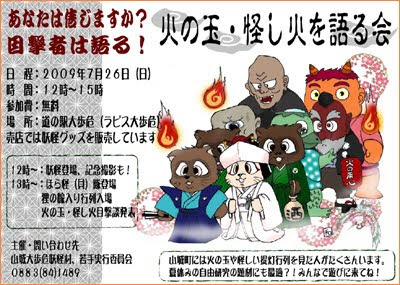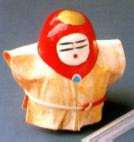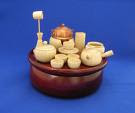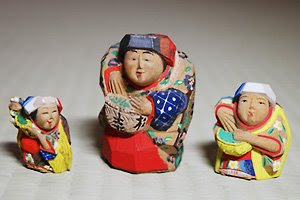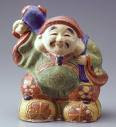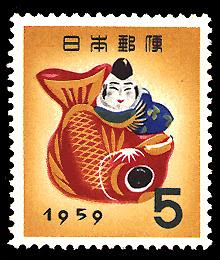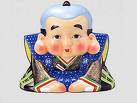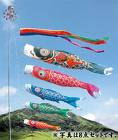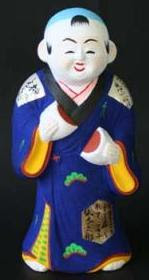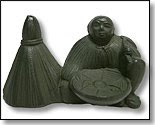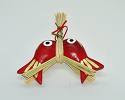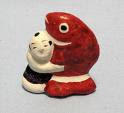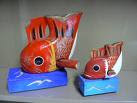::::::::::::::::::::::::::::::::::::::::::::::::::::::::::::::::::::::::::::::::::::::::::::::::::::
Shagiri festival music (しゃぎり)
***** Location: Japan
***** Season: Topic
***** Category: Humanity
shagiri manjuu しゃぎり饅頭
bun for the Shagiri festival music
A bun with an old wheel pattern しゃぎり車, filled with fine red beanpaste and walnuts.
shagiri 車切
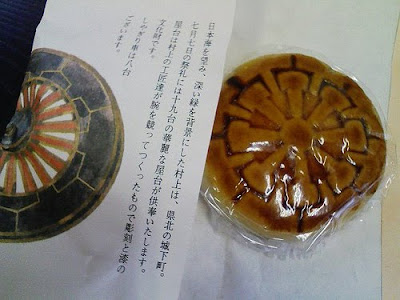
村上銘菓 しゃぎり , Murakami, Niigata
oshagiri おしゃぎり(お囃子)
In Murakami village, the carts are 5 meters high and have two wheels of about 2 meters in diameter. The cart has two stories, in the first one is the children's musician group, in the second floor are decorations.
In the early Edo period the feudal lord of the Murakami region, Hori Naoki, moved Haguro Shrine to its current location. The town celebrated this event by parading through the streets with drums carried on large hand-drawn carts.
The cart later changed its form into the present shagiri, coated with beautiful vermilion and black lacquer. Nineteen carts come together from neighboring towns to compete in their beauty. The festival peaks at sunset, when lanterns highlight the splendor of the shagiri.

shagiri surigane bells 摺鉦すりがね(鉦・かね)
囃子 is also read hayashi, as in
祭り囃子 matsuri-bayashi, festival music band
Bells and Japanese Music
matsubayashi, matsu-bayashi まつばやし【松囃子/松拍子】
. first music procession of the new year.
:::::::::::::::::::::::::::::::::::::::::::::::::::::::::::::::::::::::::::::::::::::::::::::::::::
quote
Shagiri Music at Nagahama-Hikiyama Festival
Nagahama-shi, Shiga-ken
Introduction of the Performing Art
The Nagahama-Hikiyama Festival began as a recreation of tachi-watari processions that had been undertaken during the time that Hashiba (later Toyotomi) Hideyoshi was the feudal lord of Nagahama. Hikiyama (floats) were later added to this procession to become a festival of floats as this festival is in its present form. Delighted at the birth of a son, Hideyoshi distributed gold dust to the residents of the local town, who were said to have produced hikiyama floats using this gold dust for use in festivals.
The festival was designated an intangible folk-cultural asset of national importance in 1979.
The traditional performing arts performed at the festival consist of kodomo-kyogen plays (kabuki performances) and festival music. The festival music is referred to as shagiri at the festival and consists of the use of flutes, drums, and surigane gongs. Records from 1792 indicate that performances were already being given “to the accompaniment of the shagiri music.”
 The festival music was originally played to move objects imbued with divine spirits. The shagiri music attached to a hikiyama float would always be played when moving the hikiyama float. It is believed that shagiri music came to be needed to move a hikiyama float upon its construction.
The festival music was originally played to move objects imbued with divine spirits. The shagiri music attached to a hikiyama float would always be played when moving the hikiyama float. It is believed that shagiri music came to be needed to move a hikiyama float upon its construction.Problems the community faced before the launch of the project, and the factors which caused the decline of and threatened the performing art
The shagiri musicians used to consist of the adult members of yamagumi groups. As shagiri music also came to be performed in neighbouring towns and villages with their own hikiyama floats, the people from the neighbouring areas were invited to participate in the festival. Thus, the northeast part of Shiga Prefecture, which encompasses Nagahama City, is referred to as the Kohoku Shagiri Culture Zone.
Shagiri music suffered from a decline in the number of custodians as the festival was suspended between 1937 and 1948 as the Sino-Japanese War and the Second World War raged on, and young men who were crucial to transmitting shagiri music were sent to the front. In addition, the shagiri musicians from neighbouring areas who had previously participated in the festival also started to avoid participating during 1960s due to aging, a lack of successors, and busy work schedule. At the same time, few people wished to learn shagiri music, perhaps due in part to the fact that it was taught through symbols and oral means. Thus, some had to use tape recorders to provide accompanying music during festival processions.
Details of the project for solving problems of the performing art, especially who and how it started, finance, and involvement of younger generation
The Nagahama-Hikiyama Festival Shagiri Preservation Society is engaged in activities with the aims of preserving the shagiri music, surveying original pieces transmitted within each yamagumi group, and cultivating successors. The Society endeavours to apply staff notations using musical notes to shagiri pieces and strives to disseminate shagiri music to the wakashu members in each yamagumi group. The Society also aspires to broadly promote local performing arts to the area in conjunction with the festival.
Read the full text here
source : Asia/Pacific Cultural Centre for UNESCO (ACCU) 2007
長浜曳山まつり
. . . CLICK here for Photos of Nakahama !
. Nagahama Hikiyama Kyoogen 長浜曳山狂言
observance kigo for late spring
:::::::::::::::::::::::::::::::::::::::::::::::::::::::::::::::::::::::::::::::::::::::::::::::::::
Shagiri Festival, Kurashiki
Okayama prefecture
鴻八幡宮例大祭(しゃぎり 車切)
鴻八幡宮(こうはちまんぐう)Koo Hachimangu
Shagiri-bayashi is a kind of festival music, where the band sits on a float. Flute, large drums and bells are used.

. . . CLICK here for Photos !
*****************************
Worldwide use
*****************************
Things found on the way
*****************************
HAIKU and SENRYU
matsubayashi
一斉に平伏したり松囃子
高橋すゝむ
上京は都さびたり松囃子
絵扇をひさぐ家なり松囃子
松瀬青々
朱柱に侍る地謡松囃子
山田弘子 初期作品
松囃子金剛流と停まり聴く
谷口自然
減つてゆく博多の人や松囃子
小原菁々子
笏正しく居睡る禰宜や松囃子
佐野青陽人
肩衣を受けて終りや松囃子
佐野ゝ石
source : HAIKUreikuDB
*****************************
Related words
***** WASHOKU : Regional Japanese Dishes
***** WAGASHI ... Sweets SAIJIKI
:::::::::::::::::::::::::::::::::::::::::::::::::::::::::::::::::::::::::::::::::::::::::::::::::::::
[ . BACK to WORLDKIGO . TOP . ]
[ . BACK to DARUMA MUSEUM TOP . ]
:::::::::::::::::::::::::::::::::::::::::::::::::::::::::::::::::::::::::::::::::::::::::::::::::::::


